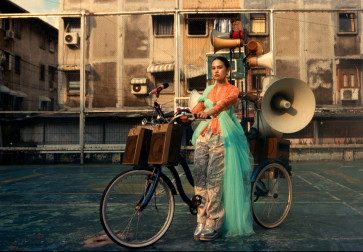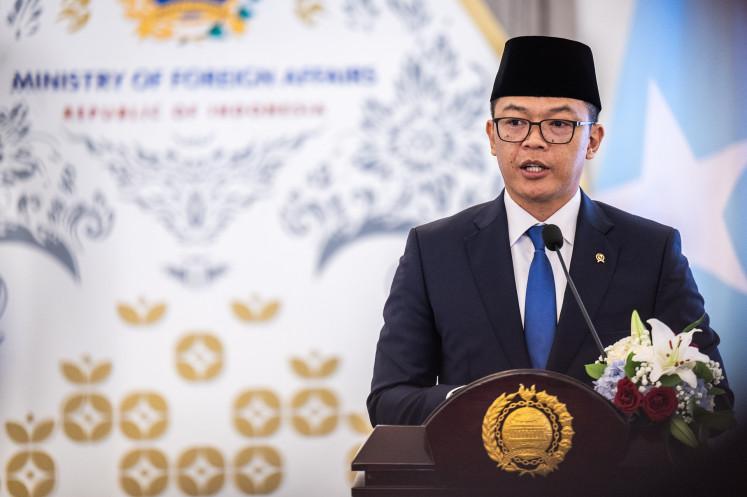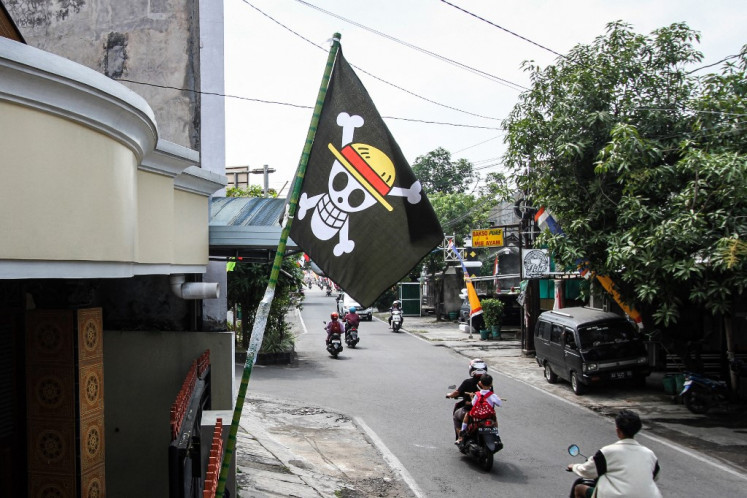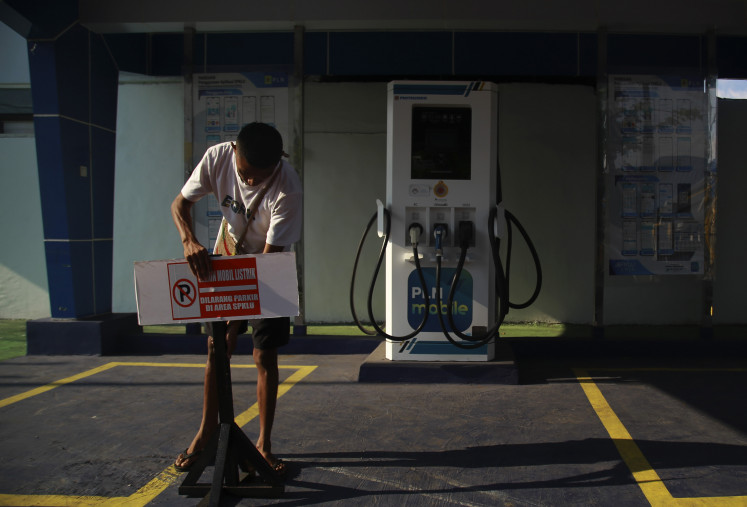Popular Reads
Top Results
Can't find what you're looking for?
View all search resultsPopular Reads
Top Results
Can't find what you're looking for?
View all search results25 years of the Cemeti Art House: ‘Realities’
Archives: Posters from Cemeti’s 25-year history are on display in the background while a work of S
Change text size
Gift Premium Articles
to Anyone
Archives: Posters from Cemeti’s 25-year history are on display in the background while a work of S. Teddy D., Kultur Sadis (Sadistic Culture) (2002) stands in the front at an exhibition called “Realities: Cemeti Archived”. The exhibition marks the Cemeti Art House’s 25th year. (JP/Andy Fuller)
“Realities: Cemeti Archived”, curated by Farah Wardani and Pitra Hutomo, is one of the exhibitions marking the Cemeti Art House’s 25th anniversary.
The Yogyakarta gallery, which was founded by Nindityo Adipurnomo and Mella Jaarsma in 1988, has exhibited works by many of the major names in Indonesian contemporary art including Heri Dono, S. Teddy, Eko Nugroho, FX Harsono and Agus Suwage.
Cemeti is a mainstay of the country’s art scene, providing exhibitions, workshops and discussions. Since 2006, Cemeti has also served as a venue for hosting residencies for artists, curators and writers. These are conducted in collaboration with Heden-The Hague and the Netherlands Embassy in Jakarta. This represents a shift from being purely an exhibition gallery to one focusing on working projects that are completed by local and foreign artists while they are based in Yogyakarta.
Cemeti was founded during the height of Soeharto’s New Order regime; a time in which there was little scope for displaying sociopolitical art. Cemeti’s arrival provided a space for experimentation and it helped foster the careers of young and emerging artists. The post-New Order era, however, has seen a diffusion of political and ideological orthodoxy.
The narrow political climate of the New Order has been supplanted by a sharp contestation of ideologies and competing sociocultural and religious values. How artists relate to their social and political realities is an ongoing concern among Cemeti artists and the discourses with which they engage. Artists, albeit to varying degrees, seek to collaborate with the societies to which they belong, as well as seeking to promote discourses on what it means to be aesthetically and creatively original while at the same evocative of their own time and space.
The “Realities” exhibition comprises video works, catalogues, a few installations (by Bambang Toko Witjaksono and Angki Purbandono, among others) and posters from previous exhibitions.
The curators have also provided a text that divides the last 25 years into roughly five-year periods.
The text, which is posted on the gallery walls, comes in three parts: the arts, the state and Yogyakarta. The narrative is clearly told and the story is compelling. This text provides a useful and relevant context in which Cemeti’s artists can be viewed. The decline of the authority of the kraton (palace) in the 1980s and 1990s, the dominance of New Order ideology and power, growing discontent in cities and the rise of student movements and alternative arts spaces in the late 1990s.
The notes emphasize both the political and social difficulties of everyday life and the growing respect toward the Cemeti Art House. The curators note the common urban dystopia of Indonesian cities, as well as an increasing Javanese “fundamentalism” in Yogyakarta over the past few years.
Posters on two of the rear walls further complement the exhibition; they are paraphernalia of previous exhibitions and provide brief samples of the aesthetics of each exhibition. They are, in effect, brief quotations of an artist’s style.
These posters are well-designed and present a quick reference point for learning the names of artists who have had their work exhibited at Cemeti and provide dates — something useful for tracking a particular artist’s trajectory.
It is a pity that the posters were not complemented by more detailed photographs of the artists’ works. There are photographs from exhibitions, but these appear too briefly in slide shows on the television screens on the gallery’s walls.
More problematic is the fact that the slow-moving photographs are not marked with the names of their respective artists. Many well-known artists appear in these images: who they all are, however, will remain a mystery to those who are not already familiar with the Cemeti and Yogyakarta art networks.
Journey: Photographs of events and exhibitions at Cemeti and invitations to exhibitions are a significant part of the exhibition. (JP/Andy Fuller)
This is a minor point and contrasts the diligence with which Nindityo and Mella have maintained the Cemeti archives. Nindityo and Mella also founded the Cemeti Art Foundation (1995), which later changed its name to the Indonesian Visual Art Archive (2007).
One of the strengths of the Cemeti is its ever-expanding network. Nindityo and Mella continually seek to involve young and emerging artists, curators and writers in the projects that are exhibited at the gallery. This degree of openness allows the Cemeti to maintain a freshness and dynamism. The Cemeti’s success is also evident in the back pages of the Turning Targets guidebook in which the supporters of the art gallery are acknowledged.
The Cemeti Art House is supported by the Friends of Cemeti, the Tourism and Creative Economy Ministry, the HD Museum, the Asia Foundation, Ciputra Artpreneur, Hivos, Erasmus Huis, the kingdom of the Netherlands and the Institut Francais/LIP. Success in promoting a discourse is collaborative and based on establishing a network and input in terms of funding plus a sense of realizing shared goals. Turning Targets, in a self-aware manner, emphasizes the challenges in realizing one’s ambitions; goals and targets are easy, realizing them is the hard part.
The catalogues that are available in the exhibition provide the best way of engaging with the Cemeti’s 25 years. The catalogues are bilingual and feature essays by local and international curators. These are well-produced documents that show the ongoing interest of foreign artists — many Dutch and Australian — who have participated in the Cemeti’s residency programs. The series, which has included projects such as Ralph Kemena’s In Transit: Yogyakarta Burocracy (sic) (2008) — a series of photographs of governmental offices, and Cilia Erens’ Soundscape Yogyakarta and Nyepi Walk (2009), show the variety of artistic practices that are incorporated into Cemeti’s outlook.
Nindityo and Mella have been successful in showing the importance of the Cemeti Art House in the landscape of contemporary art. There is indeed a strong sense of satisfaction in their work and a high production level in their exhibitions, catalogues and collaborations.
The Cemeti is a benchmark in cultural and artistic discourse. It persists as a network and site of artistic importance for national and international artists and curators. Indeed, it is a product of local, national and international interests, discourses and contributions.
“Realities”, as an exhibition, provides a starting point for becoming familiar with Cemeti’s artists and its 25-year history. A slow reading of the catalogues, in particular, proves highly rewarding.
“Realities: Cemeti Archived”
Feb. 15 to March 10
Rumah Seni Cemeti
Jl. D.I. Panjaitan 41
Yogyakarta











